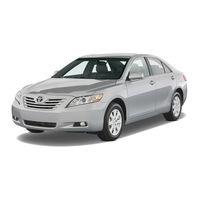Toyota 2009 Camry Manuals
Manuals and User Guides for Toyota 2009 Camry. We have 6 Toyota 2009 Camry manuals available for free PDF download: Owner's Manual, Quick Reference Manual
Toyota 2009 Camry Owner's Manual (498 pages)
Brand: Toyota
|
Category: Automobile
|
Size: 23.4 MB
Table of Contents
-
Overview4
-
Hood Release11
-
-
Lever Type13
-
Moonroof14
-
Manual Seat15
-
Power Seat15
-
-
Clock20
-
Seat Heaters21
-
CD Player22
-
Radio22
-
Audio22
-
-
Door Locks25
-
-
Symbols35
-
-
Keys50
-
-
Doors68
-
Trunk73
-
Front Seats76
-
-
-
Lock Switch95
-
Moon Roof97
-
Refueling100
-
Alarm106
-
SRS Airbags111
-
-
-
Stopping141
-
-
Parking Brake164
-
-
Center Panel171
-
Indicators172
-
Warning Lights173
-
-
Headlight Switch177
-
Fog Light Switch181
-
Cruise Control184
-
Trailer Towing198
-
Weight Limits198
-
Hitch199
-
Towing a Trailer199
-
Before Towing200
-
Maintenance200
-
Hitches201
-
Brakes202
-
Safety Chain202
-
-
-
Center Outlets213
-
Rear Outlets213
-
Plasmacluster216
-
Using the Radio227
-
Satellite Radio228
-
Subscriptions230
-
Loading Cds233
-
-
-
Ejecting Cds234
-
Repeat Play235
-
Scanning Tracks235
-
Display236
-
Error Messages236
-
Lens Cleaners237
-
-
-
Compatible Media245
-
File Names245
-
Multi-Sessions245
-
Extensions246
-
ID3 and WMA Tags246
-
Playback246
-
-
Audio Unit258
-
Normal Operation263
-
-
-
Speed Dialing268
-
Call History270
-
-
Changing the PIN277
-
Initialization278
-
-
Adding Procedure281
-
-
Interior Light288
-
Personal Lights289
-
Console Box291
-
Glove Box291
-
Cup Holders293
-
Auxiliary Boxes295
-
Sun Visors298
-
Vanity Mirrors299
-
Ashtrays301
-
To Prevent Fire301
-
Power Outlet302
-
Armrest306
-
Rear Sunshade307
-
Floor Mat309
-
Cargo Net310
-
Storage Box310
-
Trunk Features310
-
-
Compass316
-
-
-
Vehicle Interior328
-
Vehicle Exterior329
-
-
Hood335
-
-
Engine Oil341
-
Used Engine Oil346
-
Engine Coolant347
-
Adding Fluid349
-
Brake Fluid349
-
Fluid Level350
-
Battery352
-
Battery Exterior352
-
Washer Fluid355
-
Checking Tires356
-
Tire Rotation356
-
Tires356
-
Tire Life360
-
All Season Tires362
-
Summer Tires362
-
Tire Types362
-
-
Wheel Selection370
-
Wheels370
-
Key Battery375
-
-
Fuse Box Cover382
-
Bulb Locations390
-
Light Bulbs390
-
-
-
Jack Point Guide428
-
-
Overheating443
-
Emergency Hooks445
-
-
Specifications448
-
Engine Number449
-
Oil Viscosity452
-
Cooling System453
-
Ignition System453
-
Manual Transaxle454
-
Fuel Information459
-
Gasoline Quality459
-
Tire Information462
-
Tire Dimensions465
-
Treadwear467
-
Customization474
-
Initialization478
-
What to Do if494
Advertisement
Toyota 2009 Camry Quick Reference Manual (461 pages)
Brand: Toyota
|
Category: Automobile
|
Size: 20.77 MB
Table of Contents
-
-
-
Clock23
-
Cup Holders24
-
-
-
-
Keys60
-
-
-
-
Moon Roof101
-
-
Refueling
104 -
-
Transmission160
-
Parking Brake163
-
-
Cruise Control180
-
-
-
Trailer Towing195
-
Dinghy Towing196
Toyota 2009 Camry Owner's Manual (250 pages)
Brand: Toyota
|
Category: Automobile
|
Size: 1.9 MB
Table of Contents
-
-
Side Doors12
-
Trunk Lid19
-
Sun Visors76
-
Turn Signals80
-
Cruise Control100
-
Tone and Balance104
-
Radio Reception137
-
Operating Tips143
-
Side Vents145
-
Power Outlet148
-
Glove Box149
-
Auxiliary Box153
-
Cup Holder153
-
Manual Operation155
-
Floor Mat156
Advertisement
Toyota 2009 Camry Quick Reference Manual (18 pages)
Navigation System
Brand: Toyota
|
Category: Automobile
|
Size: 0.57 MB
Table of Contents
-
Search Area16
-
Routes16
-
Beep Setting17
Toyota 2009 Camry Quick Reference Manual (26 pages)
Camry 2009
Brand: Toyota
|
Category: Automobile
|
Size: 1.25 MB
Table of Contents
-
Overview4
-
Moonroof14
-
Clock20
-
Seat Heaters21
-
Cup Holders24
-
Seat Belts25
Toyota 2009 Camry Quick Reference Manual (17 pages)
Toyota Camry Product Manual
Brand: Toyota
|
Category: Automobile
|
Size: 2.68 MB
Table of Contents
-
Clock12
-
Seat Heaters12
-
Seat Belts14





